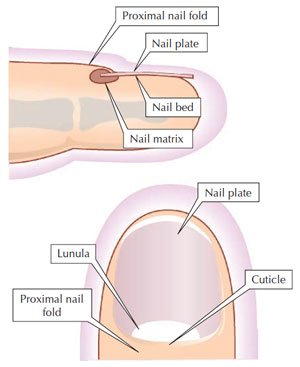|
Figure 2.7 Nail structure. (Source: Reprinted
from Graham-Brown and Burns, 2006.) |
Nails provide protection for the delicate digital ends and make fine motor operations of the fingers more effective. Although humans do not rely on the use of their nails for scratching and grooming (as other primates do), they remain a useful tool for scratching when the skin is itchy!
Like the hair follicle, the nail bed and nail fold are formed from an invagination of the epidermis. Cell division (mitosis) occurs in the nail matrix and at the proximal end of the nail; new cells are then added to the nail plate. The process of growth is complex ensuring that the nail grows flat rather than as a claw (primates being the only other mammal with nails rather than claws) (Figure 2.7). Nails allow humans and primates to make much more delicate manoeuvres with their fingers. In humans, fingernails and toenails grow through the same mechanism; however, fingernails grow at the rate of 1 mm per week and toenails more slowly. The nail bed is highly vascularised and thus pink in colour. The ‘half moon’ white area that occurs just above the cuticle (the lunule) appears paler because a thicker basal layer obscures the dermal blood vessels from view. The shape and colour of the nail can be adversely affected by trauma or inflammation. Table 2.2 gives further details on nail anatomy.
| | | | | | Table 2.2 Nail anatomy. | | Nail part | Definition | | | Nail bed | The skin on which the nail plate rests | | | Nail plate | The clear keratinised part of the nail | | | Root | Proximal end of the nail, underlying the nail fold | | | Body | Portion of the nail plate overlying the nail bed | | | Free edge | Portion of the nail plate that extends beyond the end of the finger | | | Hyponychium | The space beneath the free edge of the nail plate | | | Nail fold | The fold of skin around the margins of the nail plate | | | Eponychium | Dead epidermis that covers the proximal end of the nail: cuticle | | | Nail matrix | The growth zone of the proximal end of the nail. This corresponds to the stratum basale of the epidermis | | | Lunule | White crescent at the base of the nail | | | | | Source: Adapted from Saladin (2001). | | |
